Taxation Law: Small Business, Property Income, and Tax Concessions
VerifiedAdded on 2020/05/28
|11
|2766
|61
Essay
AI Summary
This essay provides a comprehensive overview of taxation law as it pertains to small businesses. It begins by defining small businesses and their eligibility for specific tax treatments, including reduced tax liabilities and exemptions. The essay then delves into the 2015-16 budget's tax measures, detailing changes in tax rates and the implications for both incorporated and unincorporated small businesses. It examines how property income, including rental income, is treated in tax returns, and the deductions small businesses can claim for related expenses. Furthermore, the essay explores various business expenses, such as professional services, logistical support, and financial services, and the depreciation methods applicable to capital assets. Finally, it discusses the tax concessions available to small businesses under Section 152 of the Income Tax Assessment Act 1997, including eligibility criteria based on turnover and the availability of capital gains tax relief and other concessions. The essay draws on various academic sources to support its analysis.
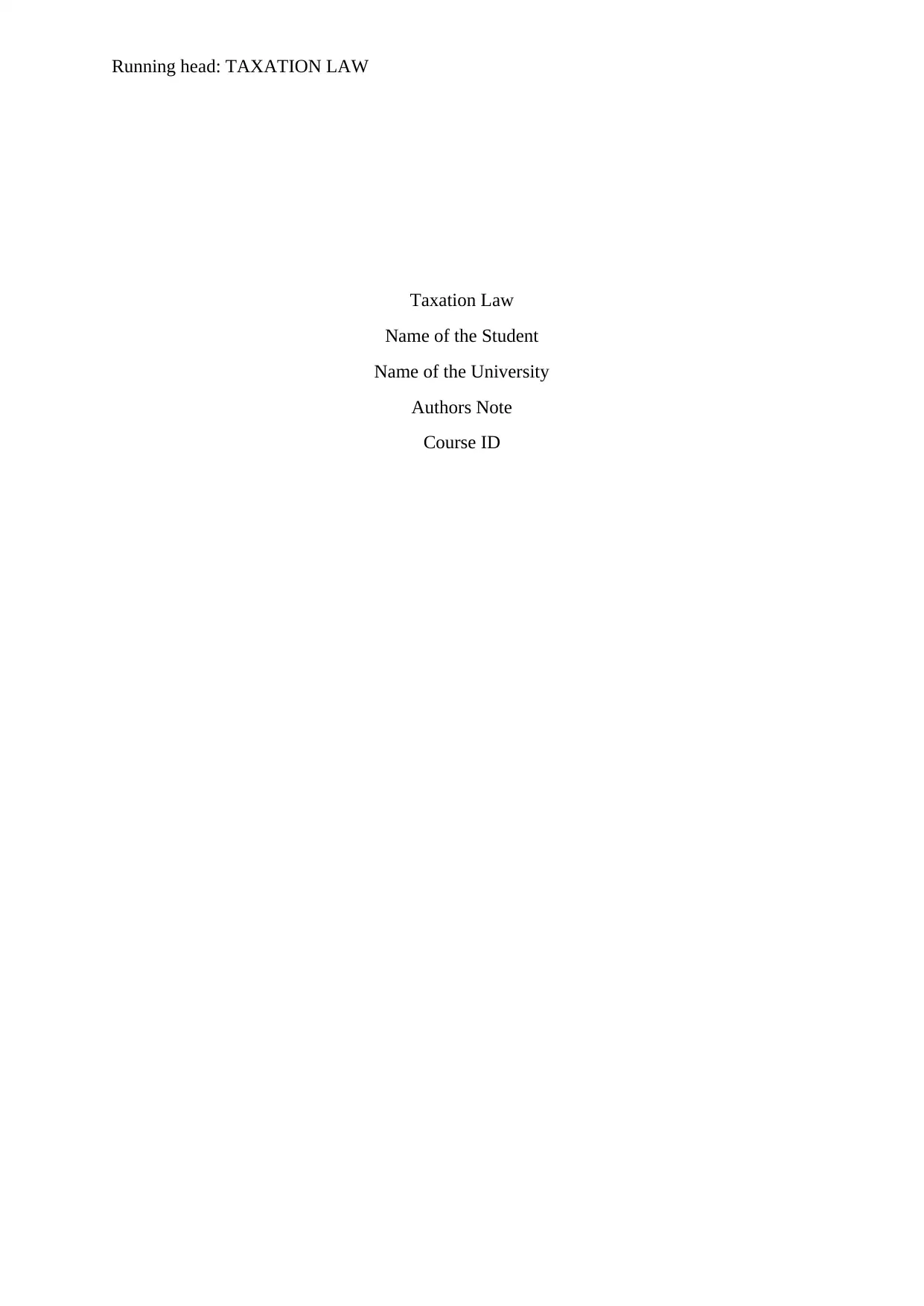
Running head: TAXATION LAW
Taxation Law
Name of the Student
Name of the University
Authors Note
Course ID
Taxation Law
Name of the Student
Name of the University
Authors Note
Course ID
Paraphrase This Document
Need a fresh take? Get an instant paraphrase of this document with our AI Paraphraser
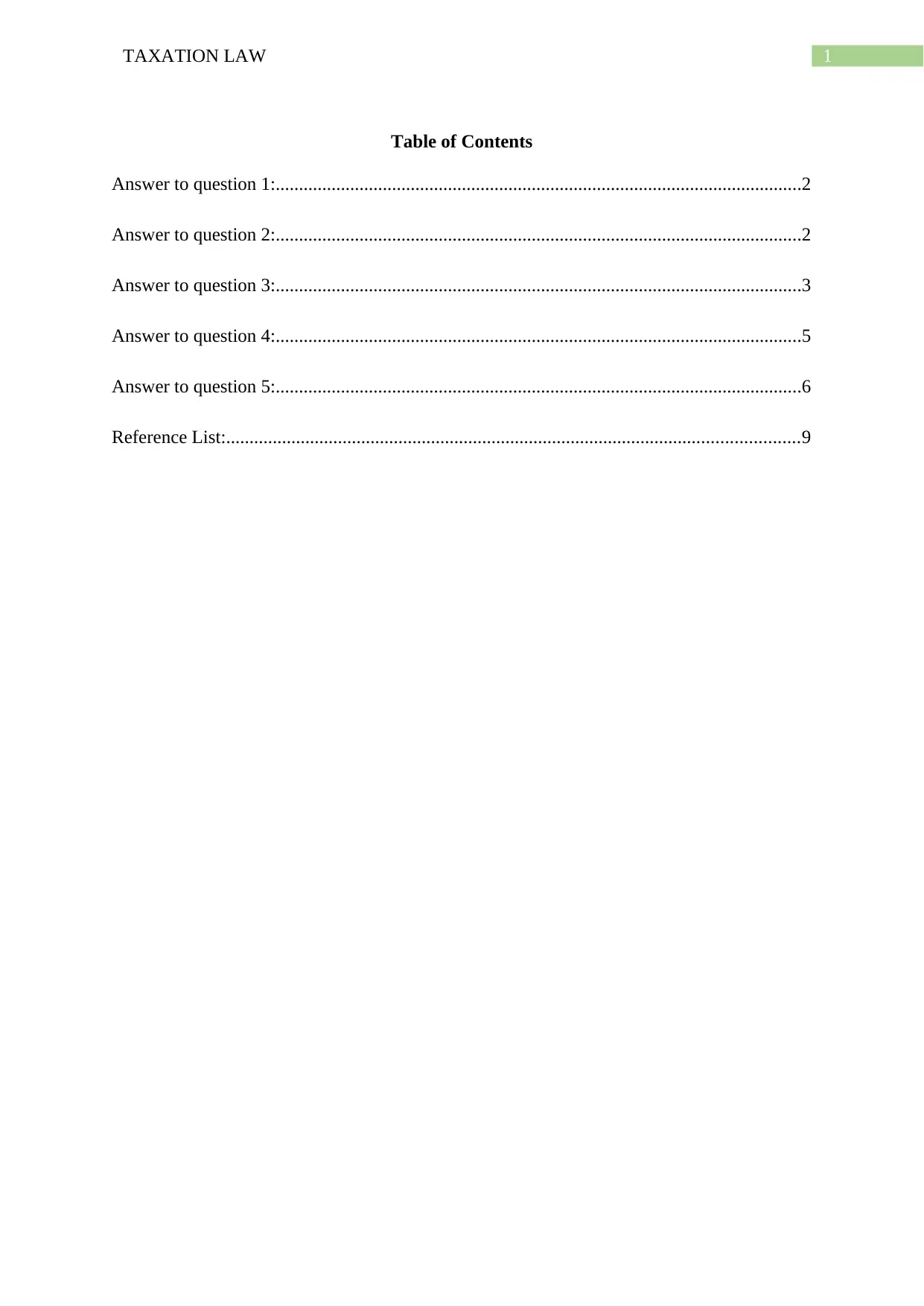
1TAXATION LAW
Table of Contents
Answer to question 1:.................................................................................................................2
Answer to question 2:.................................................................................................................2
Answer to question 3:.................................................................................................................3
Answer to question 4:.................................................................................................................5
Answer to question 5:.................................................................................................................6
Reference List:...........................................................................................................................9
Table of Contents
Answer to question 1:.................................................................................................................2
Answer to question 2:.................................................................................................................2
Answer to question 3:.................................................................................................................3
Answer to question 4:.................................................................................................................5
Answer to question 5:.................................................................................................................6
Reference List:...........................................................................................................................9
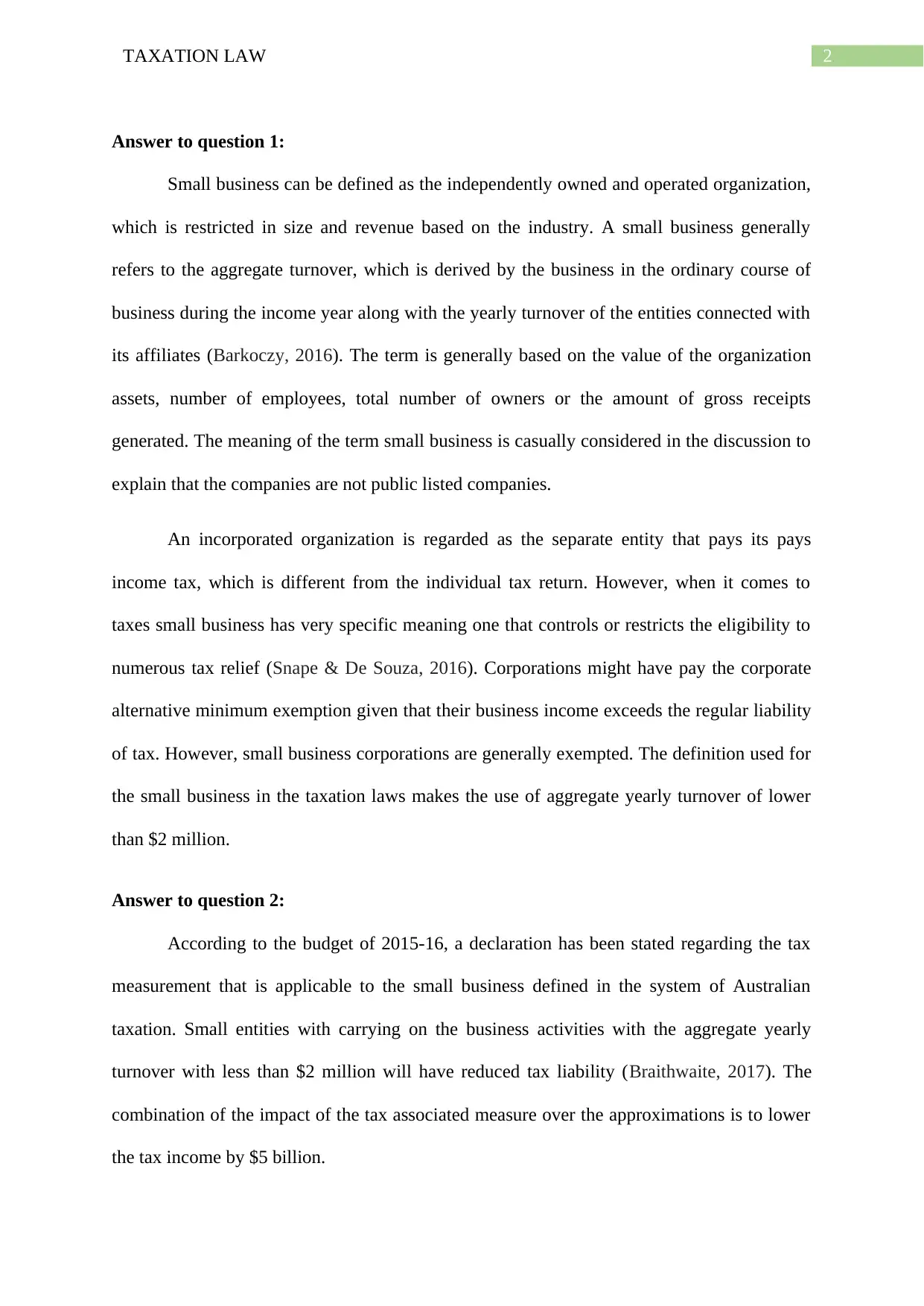
2TAXATION LAW
Answer to question 1:
Small business can be defined as the independently owned and operated organization,
which is restricted in size and revenue based on the industry. A small business generally
refers to the aggregate turnover, which is derived by the business in the ordinary course of
business during the income year along with the yearly turnover of the entities connected with
its affiliates (Barkoczy, 2016). The term is generally based on the value of the organization
assets, number of employees, total number of owners or the amount of gross receipts
generated. The meaning of the term small business is casually considered in the discussion to
explain that the companies are not public listed companies.
An incorporated organization is regarded as the separate entity that pays its pays
income tax, which is different from the individual tax return. However, when it comes to
taxes small business has very specific meaning one that controls or restricts the eligibility to
numerous tax relief (Snape & De Souza, 2016). Corporations might have pay the corporate
alternative minimum exemption given that their business income exceeds the regular liability
of tax. However, small business corporations are generally exempted. The definition used for
the small business in the taxation laws makes the use of aggregate yearly turnover of lower
than $2 million.
Answer to question 2:
According to the budget of 2015-16, a declaration has been stated regarding the tax
measurement that is applicable to the small business defined in the system of Australian
taxation. Small entities with carrying on the business activities with the aggregate yearly
turnover with less than $2 million will have reduced tax liability (Braithwaite, 2017). The
combination of the impact of the tax associated measure over the approximations is to lower
the tax income by $5 billion.
Answer to question 1:
Small business can be defined as the independently owned and operated organization,
which is restricted in size and revenue based on the industry. A small business generally
refers to the aggregate turnover, which is derived by the business in the ordinary course of
business during the income year along with the yearly turnover of the entities connected with
its affiliates (Barkoczy, 2016). The term is generally based on the value of the organization
assets, number of employees, total number of owners or the amount of gross receipts
generated. The meaning of the term small business is casually considered in the discussion to
explain that the companies are not public listed companies.
An incorporated organization is regarded as the separate entity that pays its pays
income tax, which is different from the individual tax return. However, when it comes to
taxes small business has very specific meaning one that controls or restricts the eligibility to
numerous tax relief (Snape & De Souza, 2016). Corporations might have pay the corporate
alternative minimum exemption given that their business income exceeds the regular liability
of tax. However, small business corporations are generally exempted. The definition used for
the small business in the taxation laws makes the use of aggregate yearly turnover of lower
than $2 million.
Answer to question 2:
According to the budget of 2015-16, a declaration has been stated regarding the tax
measurement that is applicable to the small business defined in the system of Australian
taxation. Small entities with carrying on the business activities with the aggregate yearly
turnover with less than $2 million will have reduced tax liability (Braithwaite, 2017). The
combination of the impact of the tax associated measure over the approximations is to lower
the tax income by $5 billion.
⊘ This is a preview!⊘
Do you want full access?
Subscribe today to unlock all pages.

Trusted by 1+ million students worldwide
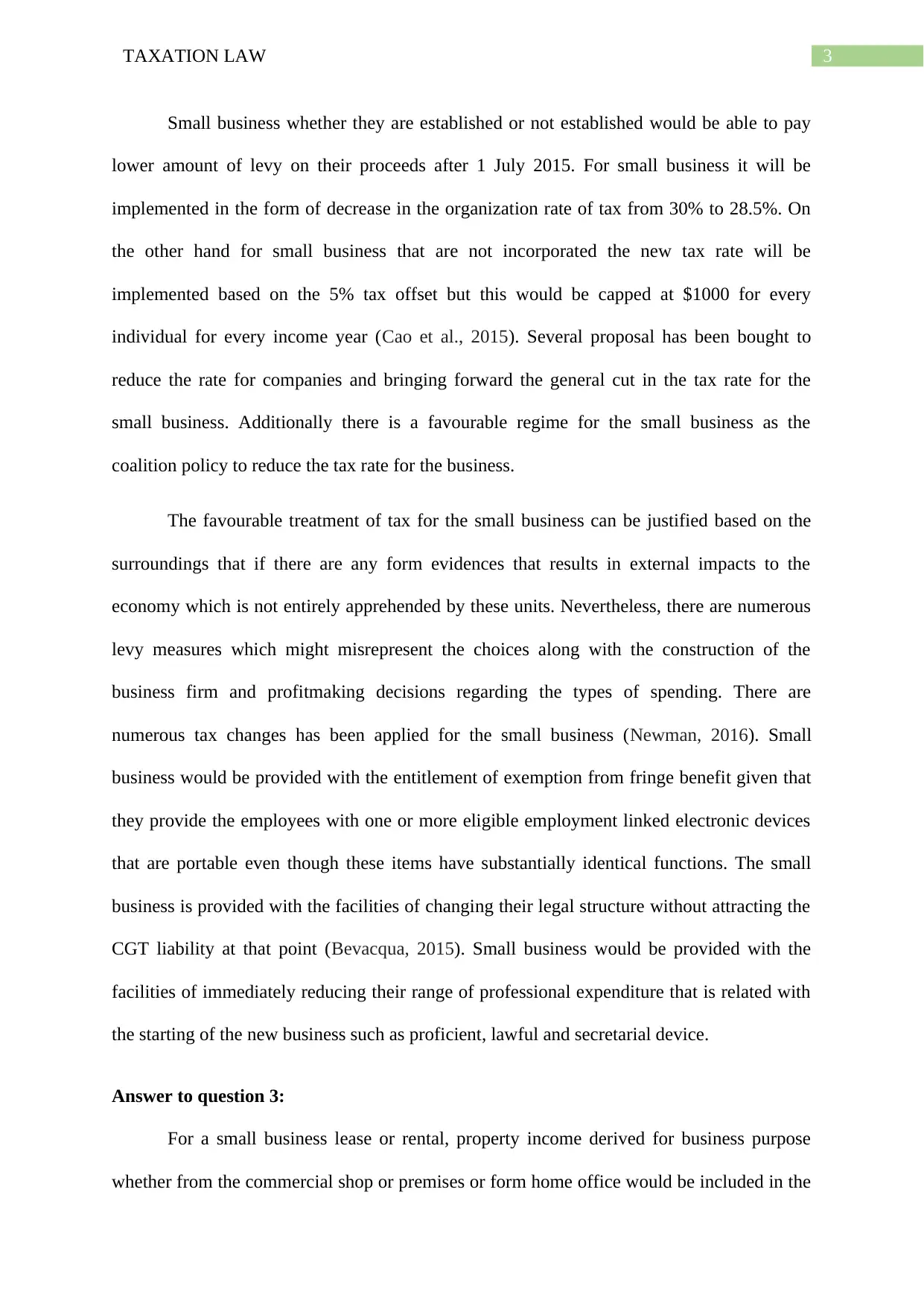
3TAXATION LAW
Small business whether they are established or not established would be able to pay
lower amount of levy on their proceeds after 1 July 2015. For small business it will be
implemented in the form of decrease in the organization rate of tax from 30% to 28.5%. On
the other hand for small business that are not incorporated the new tax rate will be
implemented based on the 5% tax offset but this would be capped at $1000 for every
individual for every income year (Cao et al., 2015). Several proposal has been bought to
reduce the rate for companies and bringing forward the general cut in the tax rate for the
small business. Additionally there is a favourable regime for the small business as the
coalition policy to reduce the tax rate for the business.
The favourable treatment of tax for the small business can be justified based on the
surroundings that if there are any form evidences that results in external impacts to the
economy which is not entirely apprehended by these units. Nevertheless, there are numerous
levy measures which might misrepresent the choices along with the construction of the
business firm and profitmaking decisions regarding the types of spending. There are
numerous tax changes has been applied for the small business (Newman, 2016). Small
business would be provided with the entitlement of exemption from fringe benefit given that
they provide the employees with one or more eligible employment linked electronic devices
that are portable even though these items have substantially identical functions. The small
business is provided with the facilities of changing their legal structure without attracting the
CGT liability at that point (Bevacqua, 2015). Small business would be provided with the
facilities of immediately reducing their range of professional expenditure that is related with
the starting of the new business such as proficient, lawful and secretarial device.
Answer to question 3:
For a small business lease or rental, property income derived for business purpose
whether from the commercial shop or premises or form home office would be included in the
Small business whether they are established or not established would be able to pay
lower amount of levy on their proceeds after 1 July 2015. For small business it will be
implemented in the form of decrease in the organization rate of tax from 30% to 28.5%. On
the other hand for small business that are not incorporated the new tax rate will be
implemented based on the 5% tax offset but this would be capped at $1000 for every
individual for every income year (Cao et al., 2015). Several proposal has been bought to
reduce the rate for companies and bringing forward the general cut in the tax rate for the
small business. Additionally there is a favourable regime for the small business as the
coalition policy to reduce the tax rate for the business.
The favourable treatment of tax for the small business can be justified based on the
surroundings that if there are any form evidences that results in external impacts to the
economy which is not entirely apprehended by these units. Nevertheless, there are numerous
levy measures which might misrepresent the choices along with the construction of the
business firm and profitmaking decisions regarding the types of spending. There are
numerous tax changes has been applied for the small business (Newman, 2016). Small
business would be provided with the entitlement of exemption from fringe benefit given that
they provide the employees with one or more eligible employment linked electronic devices
that are portable even though these items have substantially identical functions. The small
business is provided with the facilities of changing their legal structure without attracting the
CGT liability at that point (Bevacqua, 2015). Small business would be provided with the
facilities of immediately reducing their range of professional expenditure that is related with
the starting of the new business such as proficient, lawful and secretarial device.
Answer to question 3:
For a small business lease or rental, property income derived for business purpose
whether from the commercial shop or premises or form home office would be included in the
Paraphrase This Document
Need a fresh take? Get an instant paraphrase of this document with our AI Paraphraser
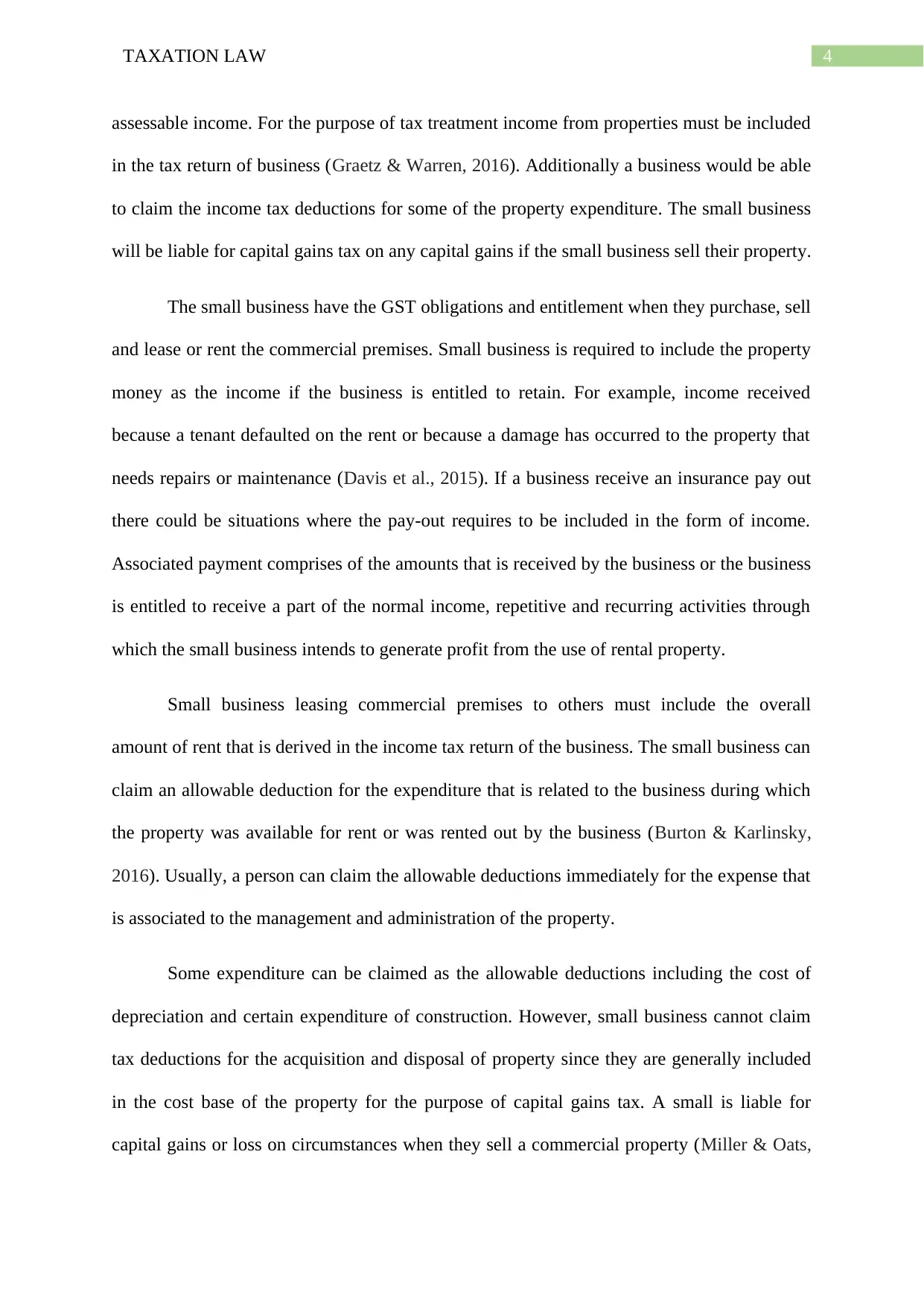
4TAXATION LAW
assessable income. For the purpose of tax treatment income from properties must be included
in the tax return of business (Graetz & Warren, 2016). Additionally a business would be able
to claim the income tax deductions for some of the property expenditure. The small business
will be liable for capital gains tax on any capital gains if the small business sell their property.
The small business have the GST obligations and entitlement when they purchase, sell
and lease or rent the commercial premises. Small business is required to include the property
money as the income if the business is entitled to retain. For example, income received
because a tenant defaulted on the rent or because a damage has occurred to the property that
needs repairs or maintenance (Davis et al., 2015). If a business receive an insurance pay out
there could be situations where the pay-out requires to be included in the form of income.
Associated payment comprises of the amounts that is received by the business or the business
is entitled to receive a part of the normal income, repetitive and recurring activities through
which the small business intends to generate profit from the use of rental property.
Small business leasing commercial premises to others must include the overall
amount of rent that is derived in the income tax return of the business. The small business can
claim an allowable deduction for the expenditure that is related to the business during which
the property was available for rent or was rented out by the business (Burton & Karlinsky,
2016). Usually, a person can claim the allowable deductions immediately for the expense that
is associated to the management and administration of the property.
Some expenditure can be claimed as the allowable deductions including the cost of
depreciation and certain expenditure of construction. However, small business cannot claim
tax deductions for the acquisition and disposal of property since they are generally included
in the cost base of the property for the purpose of capital gains tax. A small is liable for
capital gains or loss on circumstances when they sell a commercial property (Miller & Oats,
assessable income. For the purpose of tax treatment income from properties must be included
in the tax return of business (Graetz & Warren, 2016). Additionally a business would be able
to claim the income tax deductions for some of the property expenditure. The small business
will be liable for capital gains tax on any capital gains if the small business sell their property.
The small business have the GST obligations and entitlement when they purchase, sell
and lease or rent the commercial premises. Small business is required to include the property
money as the income if the business is entitled to retain. For example, income received
because a tenant defaulted on the rent or because a damage has occurred to the property that
needs repairs or maintenance (Davis et al., 2015). If a business receive an insurance pay out
there could be situations where the pay-out requires to be included in the form of income.
Associated payment comprises of the amounts that is received by the business or the business
is entitled to receive a part of the normal income, repetitive and recurring activities through
which the small business intends to generate profit from the use of rental property.
Small business leasing commercial premises to others must include the overall
amount of rent that is derived in the income tax return of the business. The small business can
claim an allowable deduction for the expenditure that is related to the business during which
the property was available for rent or was rented out by the business (Burton & Karlinsky,
2016). Usually, a person can claim the allowable deductions immediately for the expense that
is associated to the management and administration of the property.
Some expenditure can be claimed as the allowable deductions including the cost of
depreciation and certain expenditure of construction. However, small business cannot claim
tax deductions for the acquisition and disposal of property since they are generally included
in the cost base of the property for the purpose of capital gains tax. A small is liable for
capital gains or loss on circumstances when they sell a commercial property (Miller & Oats,
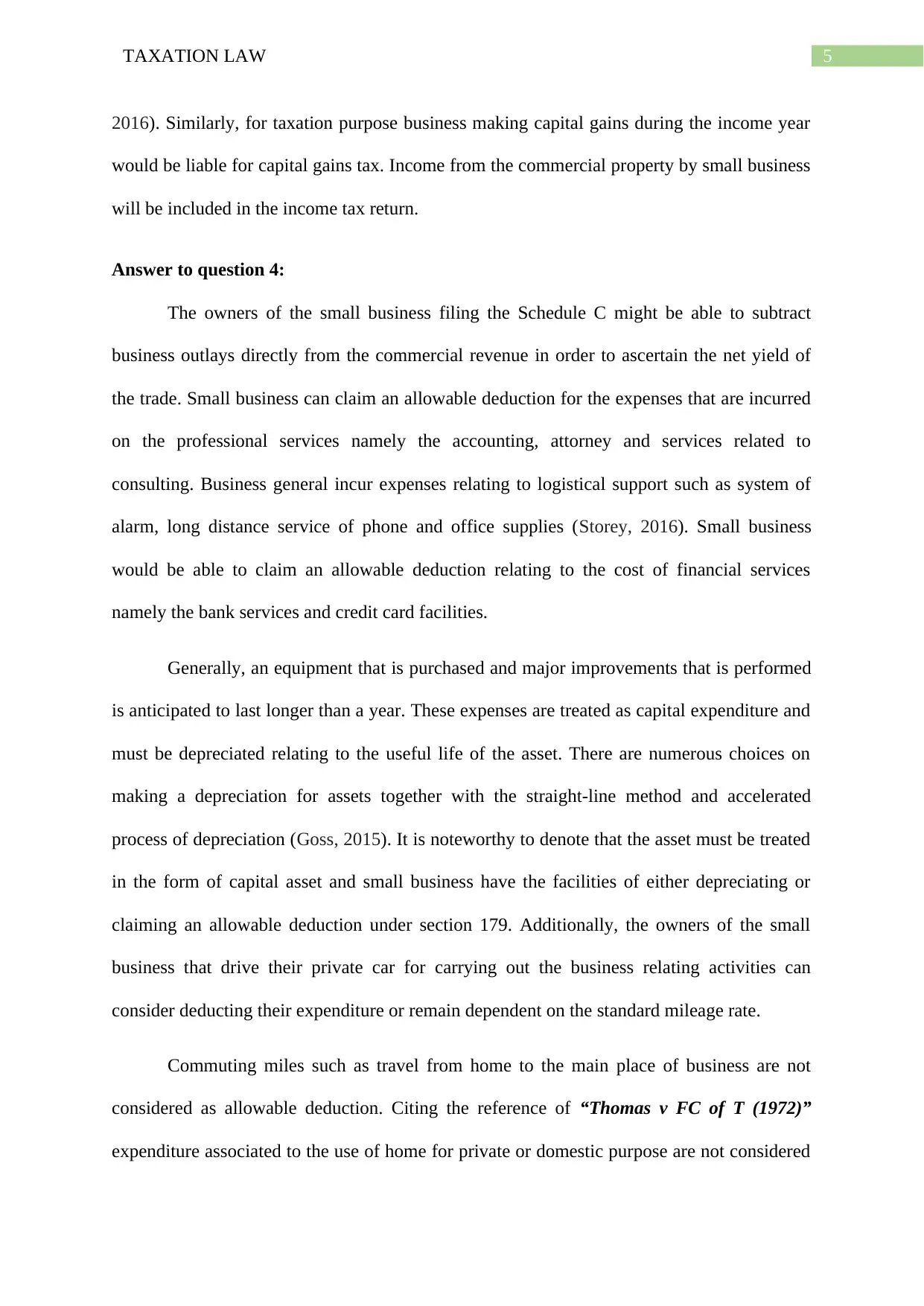
5TAXATION LAW
2016). Similarly, for taxation purpose business making capital gains during the income year
would be liable for capital gains tax. Income from the commercial property by small business
will be included in the income tax return.
Answer to question 4:
The owners of the small business filing the Schedule C might be able to subtract
business outlays directly from the commercial revenue in order to ascertain the net yield of
the trade. Small business can claim an allowable deduction for the expenses that are incurred
on the professional services namely the accounting, attorney and services related to
consulting. Business general incur expenses relating to logistical support such as system of
alarm, long distance service of phone and office supplies (Storey, 2016). Small business
would be able to claim an allowable deduction relating to the cost of financial services
namely the bank services and credit card facilities.
Generally, an equipment that is purchased and major improvements that is performed
is anticipated to last longer than a year. These expenses are treated as capital expenditure and
must be depreciated relating to the useful life of the asset. There are numerous choices on
making a depreciation for assets together with the straight-line method and accelerated
process of depreciation (Goss, 2015). It is noteworthy to denote that the asset must be treated
in the form of capital asset and small business have the facilities of either depreciating or
claiming an allowable deduction under section 179. Additionally, the owners of the small
business that drive their private car for carrying out the business relating activities can
consider deducting their expenditure or remain dependent on the standard mileage rate.
Commuting miles such as travel from home to the main place of business are not
considered as allowable deduction. Citing the reference of “Thomas v FC of T (1972)”
expenditure associated to the use of home for private or domestic purpose are not considered
2016). Similarly, for taxation purpose business making capital gains during the income year
would be liable for capital gains tax. Income from the commercial property by small business
will be included in the income tax return.
Answer to question 4:
The owners of the small business filing the Schedule C might be able to subtract
business outlays directly from the commercial revenue in order to ascertain the net yield of
the trade. Small business can claim an allowable deduction for the expenses that are incurred
on the professional services namely the accounting, attorney and services related to
consulting. Business general incur expenses relating to logistical support such as system of
alarm, long distance service of phone and office supplies (Storey, 2016). Small business
would be able to claim an allowable deduction relating to the cost of financial services
namely the bank services and credit card facilities.
Generally, an equipment that is purchased and major improvements that is performed
is anticipated to last longer than a year. These expenses are treated as capital expenditure and
must be depreciated relating to the useful life of the asset. There are numerous choices on
making a depreciation for assets together with the straight-line method and accelerated
process of depreciation (Goss, 2015). It is noteworthy to denote that the asset must be treated
in the form of capital asset and small business have the facilities of either depreciating or
claiming an allowable deduction under section 179. Additionally, the owners of the small
business that drive their private car for carrying out the business relating activities can
consider deducting their expenditure or remain dependent on the standard mileage rate.
Commuting miles such as travel from home to the main place of business are not
considered as allowable deduction. Citing the reference of “Thomas v FC of T (1972)”
expenditure associated to the use of home for private or domestic purpose are not considered
⊘ This is a preview!⊘
Do you want full access?
Subscribe today to unlock all pages.

Trusted by 1+ million students worldwide
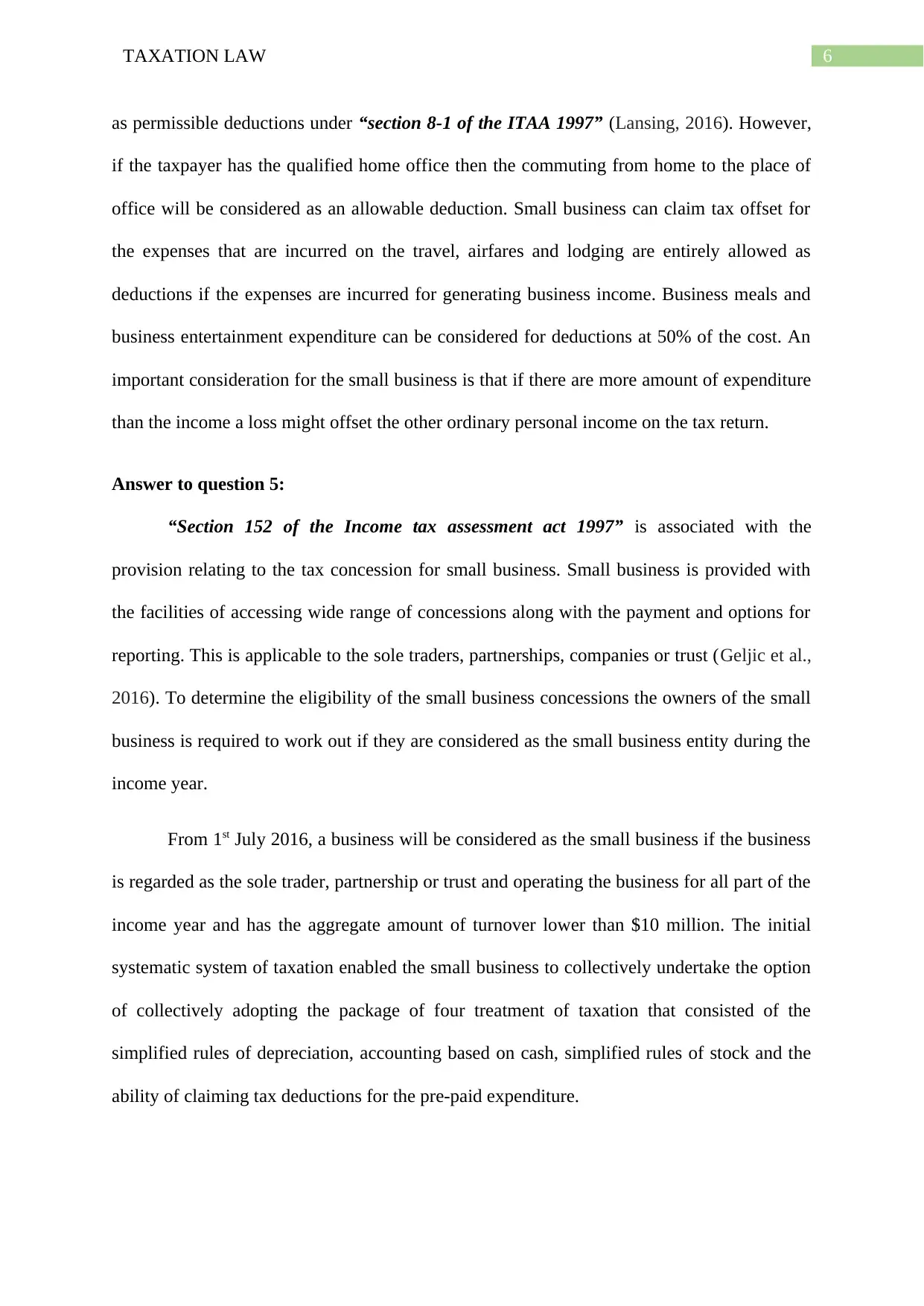
6TAXATION LAW
as permissible deductions under “section 8-1 of the ITAA 1997” (Lansing, 2016). However,
if the taxpayer has the qualified home office then the commuting from home to the place of
office will be considered as an allowable deduction. Small business can claim tax offset for
the expenses that are incurred on the travel, airfares and lodging are entirely allowed as
deductions if the expenses are incurred for generating business income. Business meals and
business entertainment expenditure can be considered for deductions at 50% of the cost. An
important consideration for the small business is that if there are more amount of expenditure
than the income a loss might offset the other ordinary personal income on the tax return.
Answer to question 5:
“Section 152 of the Income tax assessment act 1997” is associated with the
provision relating to the tax concession for small business. Small business is provided with
the facilities of accessing wide range of concessions along with the payment and options for
reporting. This is applicable to the sole traders, partnerships, companies or trust (Geljic et al.,
2016). To determine the eligibility of the small business concessions the owners of the small
business is required to work out if they are considered as the small business entity during the
income year.
From 1st July 2016, a business will be considered as the small business if the business
is regarded as the sole trader, partnership or trust and operating the business for all part of the
income year and has the aggregate amount of turnover lower than $10 million. The initial
systematic system of taxation enabled the small business to collectively undertake the option
of collectively adopting the package of four treatment of taxation that consisted of the
simplified rules of depreciation, accounting based on cash, simplified rules of stock and the
ability of claiming tax deductions for the pre-paid expenditure.
as permissible deductions under “section 8-1 of the ITAA 1997” (Lansing, 2016). However,
if the taxpayer has the qualified home office then the commuting from home to the place of
office will be considered as an allowable deduction. Small business can claim tax offset for
the expenses that are incurred on the travel, airfares and lodging are entirely allowed as
deductions if the expenses are incurred for generating business income. Business meals and
business entertainment expenditure can be considered for deductions at 50% of the cost. An
important consideration for the small business is that if there are more amount of expenditure
than the income a loss might offset the other ordinary personal income on the tax return.
Answer to question 5:
“Section 152 of the Income tax assessment act 1997” is associated with the
provision relating to the tax concession for small business. Small business is provided with
the facilities of accessing wide range of concessions along with the payment and options for
reporting. This is applicable to the sole traders, partnerships, companies or trust (Geljic et al.,
2016). To determine the eligibility of the small business concessions the owners of the small
business is required to work out if they are considered as the small business entity during the
income year.
From 1st July 2016, a business will be considered as the small business if the business
is regarded as the sole trader, partnership or trust and operating the business for all part of the
income year and has the aggregate amount of turnover lower than $10 million. The initial
systematic system of taxation enabled the small business to collectively undertake the option
of collectively adopting the package of four treatment of taxation that consisted of the
simplified rules of depreciation, accounting based on cash, simplified rules of stock and the
ability of claiming tax deductions for the pre-paid expenditure.
Paraphrase This Document
Need a fresh take? Get an instant paraphrase of this document with our AI Paraphraser
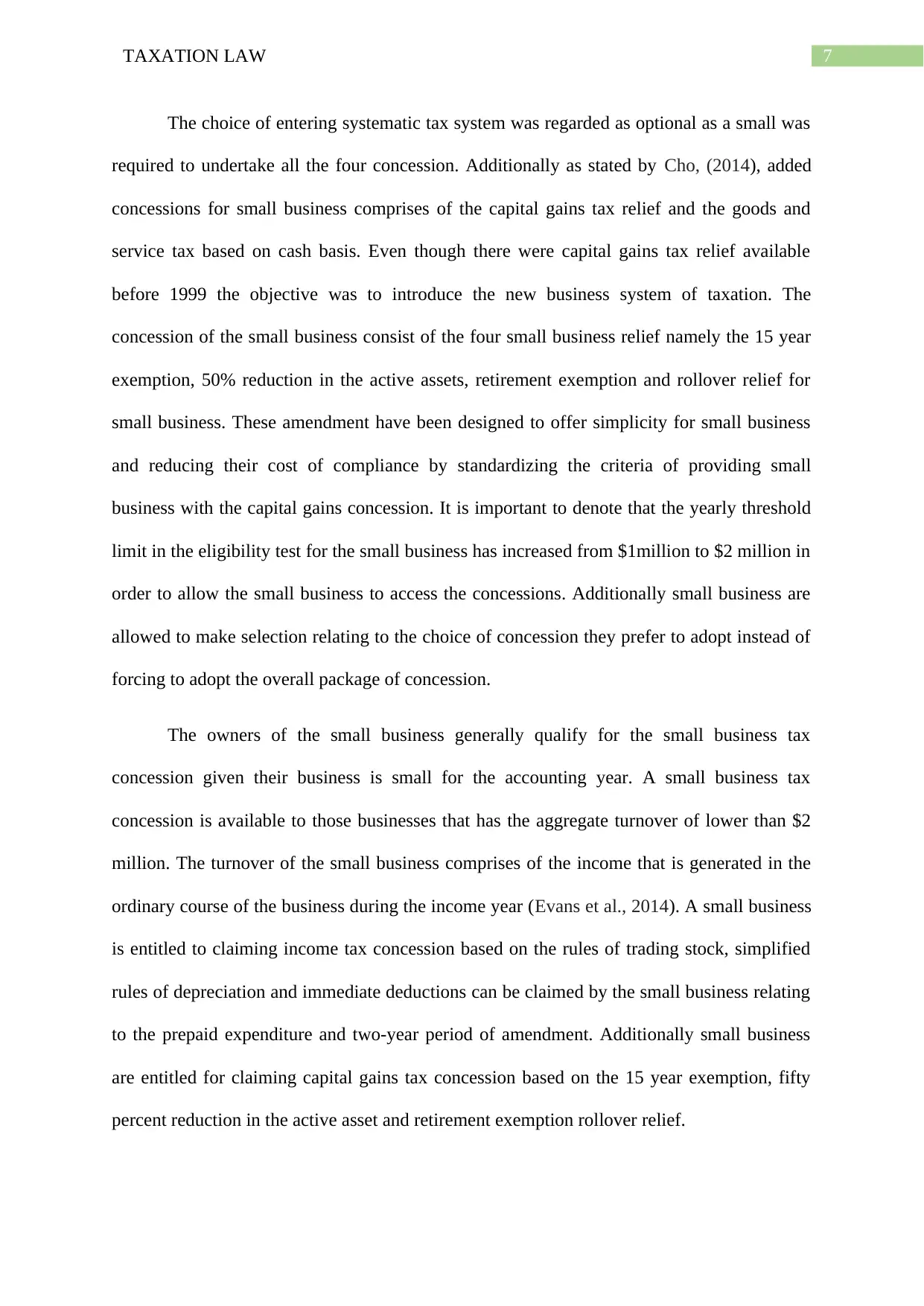
7TAXATION LAW
The choice of entering systematic tax system was regarded as optional as a small was
required to undertake all the four concession. Additionally as stated by Cho, (2014), added
concessions for small business comprises of the capital gains tax relief and the goods and
service tax based on cash basis. Even though there were capital gains tax relief available
before 1999 the objective was to introduce the new business system of taxation. The
concession of the small business consist of the four small business relief namely the 15 year
exemption, 50% reduction in the active assets, retirement exemption and rollover relief for
small business. These amendment have been designed to offer simplicity for small business
and reducing their cost of compliance by standardizing the criteria of providing small
business with the capital gains concession. It is important to denote that the yearly threshold
limit in the eligibility test for the small business has increased from $1million to $2 million in
order to allow the small business to access the concessions. Additionally small business are
allowed to make selection relating to the choice of concession they prefer to adopt instead of
forcing to adopt the overall package of concession.
The owners of the small business generally qualify for the small business tax
concession given their business is small for the accounting year. A small business tax
concession is available to those businesses that has the aggregate turnover of lower than $2
million. The turnover of the small business comprises of the income that is generated in the
ordinary course of the business during the income year (Evans et al., 2014). A small business
is entitled to claiming income tax concession based on the rules of trading stock, simplified
rules of depreciation and immediate deductions can be claimed by the small business relating
to the prepaid expenditure and two-year period of amendment. Additionally small business
are entitled for claiming capital gains tax concession based on the 15 year exemption, fifty
percent reduction in the active asset and retirement exemption rollover relief.
The choice of entering systematic tax system was regarded as optional as a small was
required to undertake all the four concession. Additionally as stated by Cho, (2014), added
concessions for small business comprises of the capital gains tax relief and the goods and
service tax based on cash basis. Even though there were capital gains tax relief available
before 1999 the objective was to introduce the new business system of taxation. The
concession of the small business consist of the four small business relief namely the 15 year
exemption, 50% reduction in the active assets, retirement exemption and rollover relief for
small business. These amendment have been designed to offer simplicity for small business
and reducing their cost of compliance by standardizing the criteria of providing small
business with the capital gains concession. It is important to denote that the yearly threshold
limit in the eligibility test for the small business has increased from $1million to $2 million in
order to allow the small business to access the concessions. Additionally small business are
allowed to make selection relating to the choice of concession they prefer to adopt instead of
forcing to adopt the overall package of concession.
The owners of the small business generally qualify for the small business tax
concession given their business is small for the accounting year. A small business tax
concession is available to those businesses that has the aggregate turnover of lower than $2
million. The turnover of the small business comprises of the income that is generated in the
ordinary course of the business during the income year (Evans et al., 2014). A small business
is entitled to claiming income tax concession based on the rules of trading stock, simplified
rules of depreciation and immediate deductions can be claimed by the small business relating
to the prepaid expenditure and two-year period of amendment. Additionally small business
are entitled for claiming capital gains tax concession based on the 15 year exemption, fifty
percent reduction in the active asset and retirement exemption rollover relief.
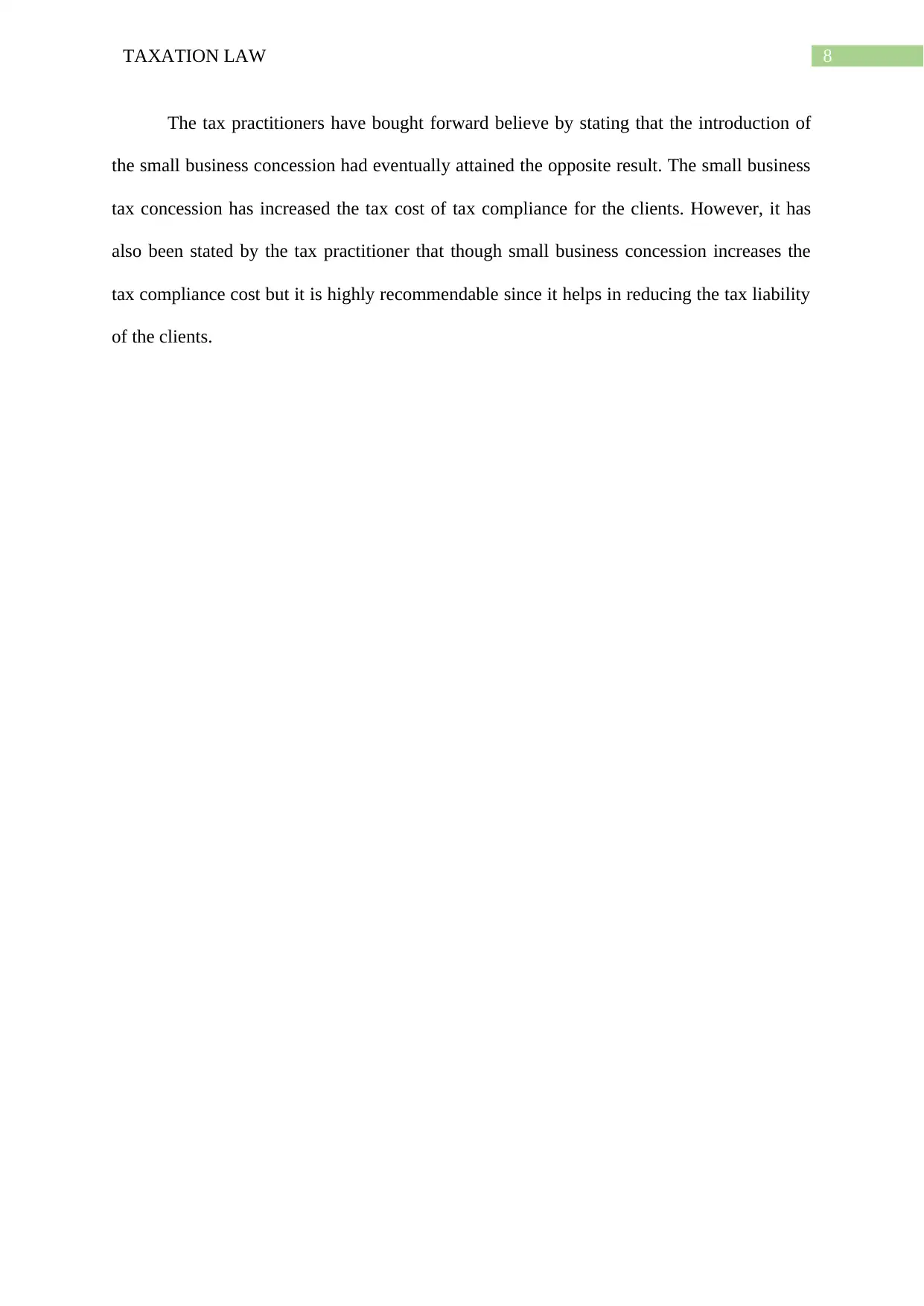
8TAXATION LAW
The tax practitioners have bought forward believe by stating that the introduction of
the small business concession had eventually attained the opposite result. The small business
tax concession has increased the tax cost of tax compliance for the clients. However, it has
also been stated by the tax practitioner that though small business concession increases the
tax compliance cost but it is highly recommendable since it helps in reducing the tax liability
of the clients.
The tax practitioners have bought forward believe by stating that the introduction of
the small business concession had eventually attained the opposite result. The small business
tax concession has increased the tax cost of tax compliance for the clients. However, it has
also been stated by the tax practitioner that though small business concession increases the
tax compliance cost but it is highly recommendable since it helps in reducing the tax liability
of the clients.
⊘ This is a preview!⊘
Do you want full access?
Subscribe today to unlock all pages.

Trusted by 1+ million students worldwide
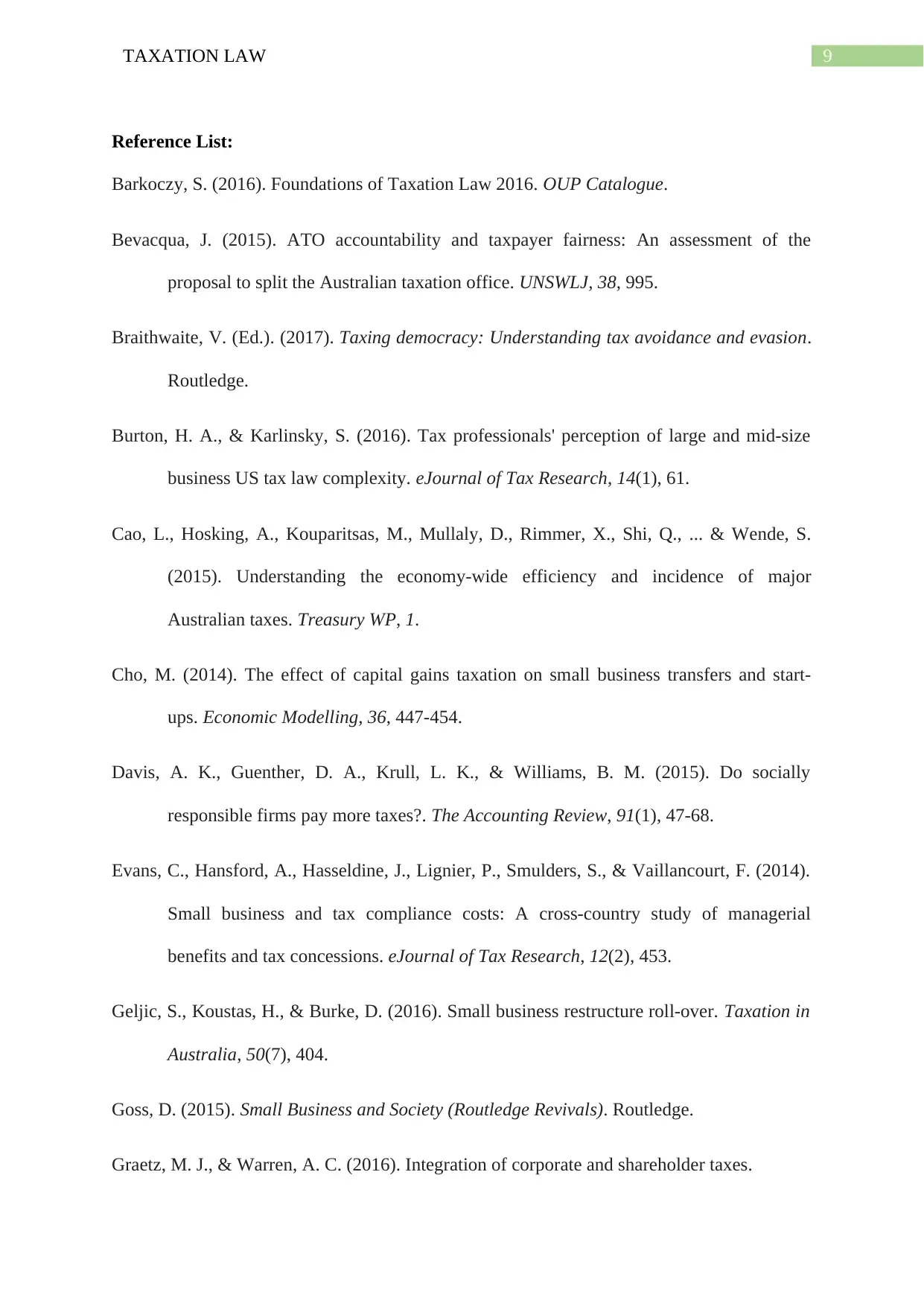
9TAXATION LAW
Reference List:
Barkoczy, S. (2016). Foundations of Taxation Law 2016. OUP Catalogue.
Bevacqua, J. (2015). ATO accountability and taxpayer fairness: An assessment of the
proposal to split the Australian taxation office. UNSWLJ, 38, 995.
Braithwaite, V. (Ed.). (2017). Taxing democracy: Understanding tax avoidance and evasion.
Routledge.
Burton, H. A., & Karlinsky, S. (2016). Tax professionals' perception of large and mid-size
business US tax law complexity. eJournal of Tax Research, 14(1), 61.
Cao, L., Hosking, A., Kouparitsas, M., Mullaly, D., Rimmer, X., Shi, Q., ... & Wende, S.
(2015). Understanding the economy-wide efficiency and incidence of major
Australian taxes. Treasury WP, 1.
Cho, M. (2014). The effect of capital gains taxation on small business transfers and start-
ups. Economic Modelling, 36, 447-454.
Davis, A. K., Guenther, D. A., Krull, L. K., & Williams, B. M. (2015). Do socially
responsible firms pay more taxes?. The Accounting Review, 91(1), 47-68.
Evans, C., Hansford, A., Hasseldine, J., Lignier, P., Smulders, S., & Vaillancourt, F. (2014).
Small business and tax compliance costs: A cross-country study of managerial
benefits and tax concessions. eJournal of Tax Research, 12(2), 453.
Geljic, S., Koustas, H., & Burke, D. (2016). Small business restructure roll-over. Taxation in
Australia, 50(7), 404.
Goss, D. (2015). Small Business and Society (Routledge Revivals). Routledge.
Graetz, M. J., & Warren, A. C. (2016). Integration of corporate and shareholder taxes.
Reference List:
Barkoczy, S. (2016). Foundations of Taxation Law 2016. OUP Catalogue.
Bevacqua, J. (2015). ATO accountability and taxpayer fairness: An assessment of the
proposal to split the Australian taxation office. UNSWLJ, 38, 995.
Braithwaite, V. (Ed.). (2017). Taxing democracy: Understanding tax avoidance and evasion.
Routledge.
Burton, H. A., & Karlinsky, S. (2016). Tax professionals' perception of large and mid-size
business US tax law complexity. eJournal of Tax Research, 14(1), 61.
Cao, L., Hosking, A., Kouparitsas, M., Mullaly, D., Rimmer, X., Shi, Q., ... & Wende, S.
(2015). Understanding the economy-wide efficiency and incidence of major
Australian taxes. Treasury WP, 1.
Cho, M. (2014). The effect of capital gains taxation on small business transfers and start-
ups. Economic Modelling, 36, 447-454.
Davis, A. K., Guenther, D. A., Krull, L. K., & Williams, B. M. (2015). Do socially
responsible firms pay more taxes?. The Accounting Review, 91(1), 47-68.
Evans, C., Hansford, A., Hasseldine, J., Lignier, P., Smulders, S., & Vaillancourt, F. (2014).
Small business and tax compliance costs: A cross-country study of managerial
benefits and tax concessions. eJournal of Tax Research, 12(2), 453.
Geljic, S., Koustas, H., & Burke, D. (2016). Small business restructure roll-over. Taxation in
Australia, 50(7), 404.
Goss, D. (2015). Small Business and Society (Routledge Revivals). Routledge.
Graetz, M. J., & Warren, A. C. (2016). Integration of corporate and shareholder taxes.
Paraphrase This Document
Need a fresh take? Get an instant paraphrase of this document with our AI Paraphraser
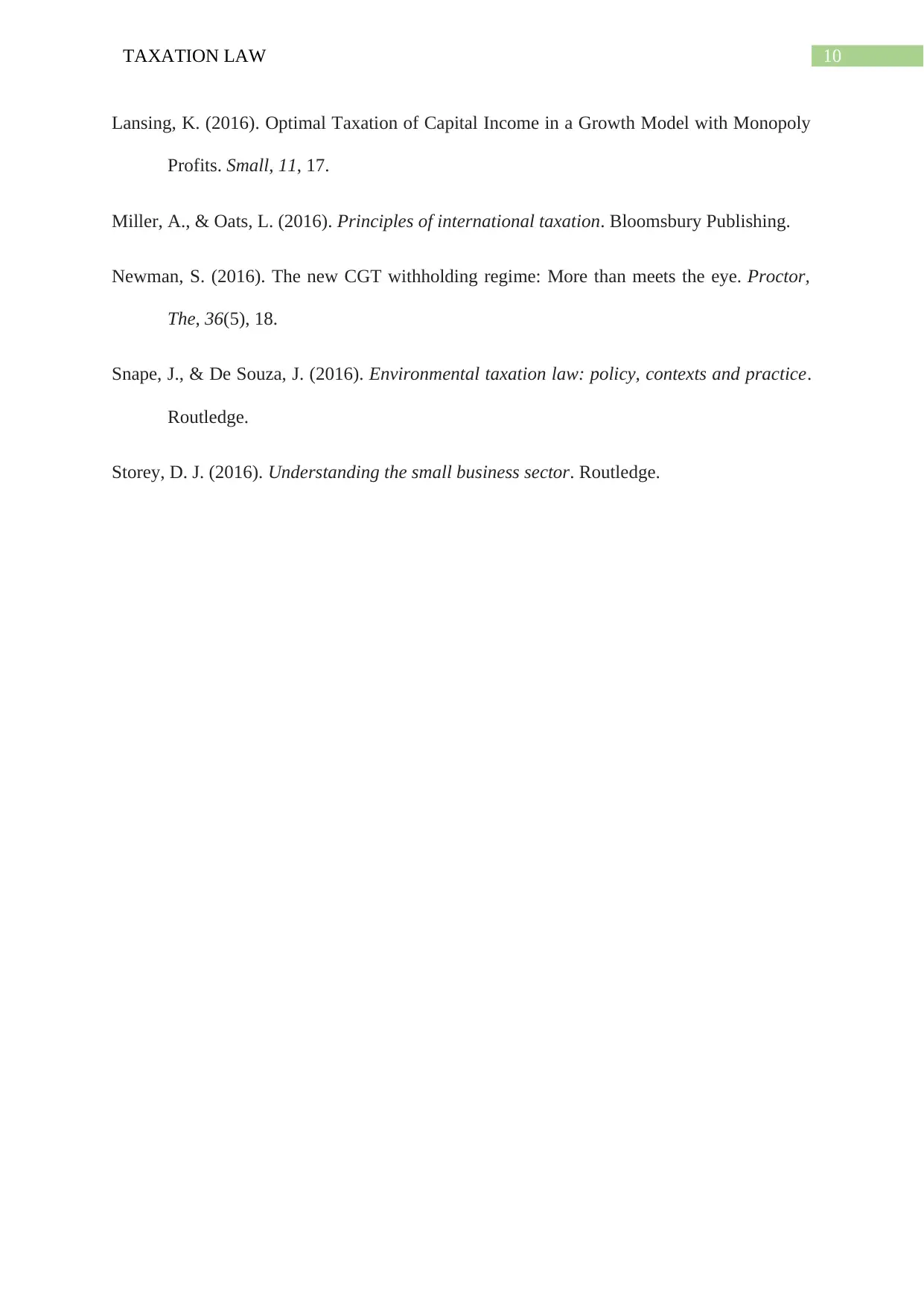
10TAXATION LAW
Lansing, K. (2016). Optimal Taxation of Capital Income in a Growth Model with Monopoly
Profits. Small, 11, 17.
Miller, A., & Oats, L. (2016). Principles of international taxation. Bloomsbury Publishing.
Newman, S. (2016). The new CGT withholding regime: More than meets the eye. Proctor,
The, 36(5), 18.
Snape, J., & De Souza, J. (2016). Environmental taxation law: policy, contexts and practice.
Routledge.
Storey, D. J. (2016). Understanding the small business sector. Routledge.
Lansing, K. (2016). Optimal Taxation of Capital Income in a Growth Model with Monopoly
Profits. Small, 11, 17.
Miller, A., & Oats, L. (2016). Principles of international taxation. Bloomsbury Publishing.
Newman, S. (2016). The new CGT withholding regime: More than meets the eye. Proctor,
The, 36(5), 18.
Snape, J., & De Souza, J. (2016). Environmental taxation law: policy, contexts and practice.
Routledge.
Storey, D. J. (2016). Understanding the small business sector. Routledge.
1 out of 11
Related Documents
Your All-in-One AI-Powered Toolkit for Academic Success.
+13062052269
info@desklib.com
Available 24*7 on WhatsApp / Email
![[object Object]](/_next/static/media/star-bottom.7253800d.svg)
Unlock your academic potential
Copyright © 2020–2025 A2Z Services. All Rights Reserved. Developed and managed by ZUCOL.





